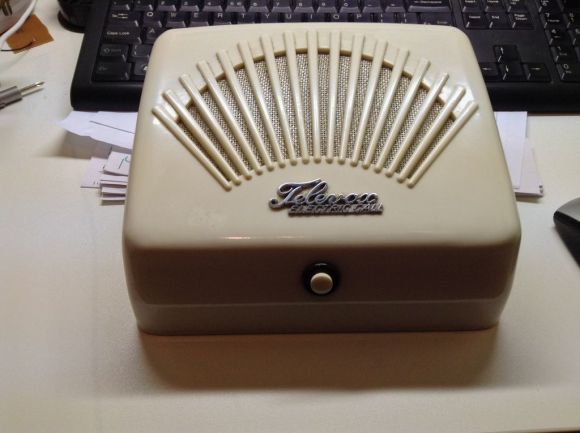
We’ve all seen the old movie scene where the executive calls his assistant on the intercom for some task or other. [Jan] may not be an executive, and he may not have an assistant. He does have Raspberri, his voice controlled personal digital assistant. Raspberri started life as a vintage Televox intercom box. [Jan] found it at a second-hand store, and snapped it up in hopes of using it in a future project. That project eventually happened when [Jan] got a Raspberry Pi and learned how to use it. He decided to build the Televox and Pi together, creating his own electronic assistant.
[Jan] started by adding a cheap USB sound card and WiFi module to his Pi. He also added a small 3 Watt audio amp board. The Televox used a single speaker as both audio input and output. [Jan] didn’t want to make any modifications to the case, so he kept this arrangement. Using a single speaker would mean dead shorting the audio amplifier and the sound card’s microphone input. To avoid this, [Jan] added a DPDT relay controlled by the original push-to-talk button on the Televox. The relay switches between the microphone input and the audio output on the USB sound card. Everything fit nicely inside the Televox case.
With the hardware complete [Jan] turned his attention to software. He went with PiAUISuite for voice input. Voice output is handled by a simple shell script which uses google voice to convert text to speech. For intermediate processing, such as scraping a weather website for data, [Jan] created custom python scripts. The end result is pretty darn good. There is a bit of lag between saying the command and receiving an answer. This may be due to transferring the audio files over WiFi. However, [Jan] can always get away with saying his assistant was out getting him more coffee!















wowowow awesome
I love re-purposing old enclosures…I look for them all the time at flea markets and hamfests.
Roger
Sure beats a plexiglass (perspex) sandwich, or laser sharp edged box.
The way he wrote up the construction of the circuit, it sounds like he is installing the relay before the amp so basically the output of the amp would be connected to the mic input when switched.
But from looking at the pics, I can see it is wired correctly. He may want to throw together a wiring diagram in case someone gets this confused.
Awesome build. I love everything made in bakelite. I have an old bakelite radio/phonograph intended for a project one day.
Hmm, after looking at the pictures more closely, I’m not sure that is bakelite.
It’s always nice to see someone do something cool with my software.
He should change “Hi there.” for “Miss Johnson” or something similar, for that old timey feel.
Ms. Johnson, you’ve never lied to me. Am I still a good person?
[on intercom] I don’t know, sir. I’m a program built into the intercom.
you forgot the 1min pause until the intercom starts speaking
Mr ChalkBored, your two o’clock magician is here.
And perhaps use the voice recognition to request a sandwich, hooking up an email to the local deli delivery service. At the same time, speakers could be triggered in the next room to play the sound of Miss Johnson using a rotary dial to order lunch for you.
But i alwalys take these things too far.
“At the same time, speakers could be triggered in the next room to play the sound of Miss Johnson using a rotary dial to order lunch for you.”
Now that’s just cheating. There should be an actual rotary phone (or at least the dial from one) and a motor!
So long as we are taking authenticity to this level he would probably need to stuff a resistor in a cigarette, place that inside the case and run just enough current to warm it up.
Nice! Excellent choice of a period music, too.
I’ll have to keep my eyes open for old intercom boxes now. (c:
Love it! I would add in a bunch of pre programmed conversations and talk to it.
is that sad?